Acid rain
Acid rain is a rain or any other form of precipitation that is unusually acidic, meaning that it has elevated levels of hydrogen ions (low pH). It can have harmful effects on plants, aquatic animals, and infrastructure. Acid rain is caused by emissions of sulphur dioxide dioxide and nitrogen oxide, which react with the water molecules in the atmosphere to produce acids. Some governments have made efforts since the 1970s[1] to reduce the release of sulfur dioxide and nitrogen oxide into the atmosphere with positive results. Nitrogen oxides can also be produced naturally by lightning strikes, and sulphur dioxide is produced by volcanic eruptions.[2] Acid rain has been shown to have adverse impacts on forests, freshwaters, and soils, killing insect and aquatic life-forms, causing paint to peel, corrosion of steel structures such as bridges, and weathering of stone buildings and statues as well as having impacts on human health.[3]


| External audio | |
|---|---|
Definition
"Acid rain" is a popular term referring to the deposition of a mixture from wet (rain, snow, sleet, fog, cloudwater, and dew) and dry (acidifying particles and gases) acidic components. Distilled water, once carbon dioxide is removed, has a neutral pH of 7. Liquids with a pH less than 7 are acidic, and those with a pH greater than 7 are alkaline. "Clean" or unpolluted rain has an acidic pH, but usually no lower than 5.7, because carbon dioxide and water in the air react together to form carbonic acid, a weak acid according to the following reaction:
Carbonic acid then can ionize in water forming low concentrations of carbonate and hydronium ions:
Unpolluted rain can also contain other chemicals which affect its pH (acidity level). A common example is nitric acid produced by electric discharge in the atmosphere such as lightning.[4] Acid deposition as an environmental issue (discussed later in the article) would include additional acids other than H2CO3.
History
The corrosive effect of polluted, acidic city air on limestone and marble was noted in the 17th century by John Evelyn, who remarked upon the poor condition of the Arundel marbles.[5] Since the Industrial Revolution, emissions of sulfur dioxide and nitrogen oxides into the atmosphere have increased.[6][7] In 1852, Robert Angus Smith was the first to show the relationship between acid rain and atmospheric pollution in Manchester, England.[8]
In the late 1960s, scientists began widely observing and studying the phenomenon.[9] The term "acid rain" was coined in 1872 by Robert Angus Smith.[10] Canadian Harold Harvey was among the first to research a "dead" lake. At first, the main focus in research lay on local effects of acid rain. Waldemar Christofer Brøgger was the first to acknowledge long-distance transportation of pollutants crossing borders from the United Kingdom to Norway.[11] Public awareness of acid rain in the US increased in the 1970s after The New York Times published reports from the Hubbard Brook Experimental Forest in New Hampshire of the harmful environmental effects that result from it.[12][13]
Occasional pH readings in rain and fog water of well below 2.4 have been reported in industrialized areas.[6] Industrial acid rain is a substantial problem in China and Russia[14][15] and areas downwind from them. These areas all burn sulfur-containing coal to generate heat and electricity.[16]
The problem of acid rain has not only increased with population and industrial growth, but has become more widespread. The use of tall smokestacks to reduce local pollution has contributed to the spread of acid rain by releasing gases into regional atmospheric circulation.[17][18] Often deposition occurs a considerable distance downwind of the emissions, with mountainous regions tending to receive the greatest deposition (because of their higher rainfall). An example of this effect is the low pH of rain which falls in Scandinavia.
In the United States
| External audio | |
|---|---|
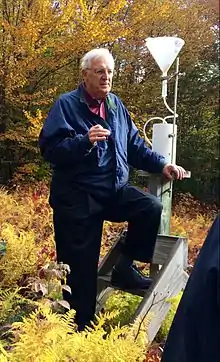 | |
%252C_Harvard_University%252C_Cambridge%252C_MA_-_IMG_4607.JPG.webp)
The earliest report about acid rain in the United States was from the chemical evidence from Hubbard Brook Valley. In 1972, a group of scientists including Gene Likens discovered the rain that was deposited at White Mountains of New Hampshire was acidic. The pH of the sample was measured to be 4.03 at Hubbard Brook.[20] The Hubbard Brook Ecosystem Study followed up with a series of research that analyzed the environmental effects of acid rain. Acid rain that mixed with stream water at Hubbard Brook was neutralized by the alumina from soils.[21] The result of this research indicates the chemical reaction between acid rain and aluminum leads to an increasing rate of soil weathering. Experimental research was done to examine the effects of increased acidity in stream on ecological species. In 1980, a group of scientists modified the acidity of Norris Brook, New Hampshire, and observed the change in species' behaviors. There was a decrease in species diversity, an increase in community dominants, and a decrease in the food web complexity.[22]
In 1980, the US Congress passed an Acid Deposition Act.[23] This Act established an 18-year assessment and research program under the direction of the National Acidic Precipitation Assessment Program (NAPAP). NAPAP looked at the entire problem from a scientific perspective. It enlarged a network of monitoring sites to determine how acidic the precipitation actually was, and to determine long-term trends, and established a network for dry deposition. Using a statistically based sampling design, NAPAP quantified the effects of acid rain on a regional basis by targeting research and surveys to identify and quantify the effects of acid precipitation on freshwater and terrestrial ecosystems. NAPAP also assessed the effects of acid rain on historical buildings, monuments, and building materials. It also funded extensive studies on atmospheric processes and potential control programs.
From the start, policy advocates from all sides attempted to influence NAPAP activities to support their particular policy advocacy efforts, or to disparage those of their opponents.[23] For the US Government's scientific enterprise, a significant impact of NAPAP were lessons learned in the assessment process and in environmental research management to a relatively large group of scientists, program managers, and the public.[24]
In 1981, the National Academy of Sciences was looking into research about the controversial issues regarding acid rain.[25] President Ronald Reagan did not place a huge attention on the issues of acid rain[26] until his personal visit to Canada and confirmed that Canadian border suffered from the drifting pollution from smokestacks in Midwest of US. Reagan honored the agreement to Canadian Prime Minister Pierre Trudeau’s enforcement of anti-pollution regulation.[27] In 1982, US President Ronald Reagan commissioned William Nierenberg to serve on the National Science Board.[28] Nierenberg selected scientists including Gene Likens to serve on a panel to draft a report on acid rain. In 1983, the panel of scientists came up with a draft report, which concluded that acid rain is a real problem and solutions should be sought.[29] White House Office of Science and Technology Policy reviewed the draft report and sent Fred Singer’s suggestions of the report, which cast doubt on the cause of acid rain.[30] The panelists revealed rejections against Singer's positions and submitted the report to Nierenberg in April. In May 1983, the House of Representatives voted against legislation that aimed to control sulfur emissions. There was a debate about whether Nierenberg delayed to release the report. Nierenberg himself denied the saying about his suppression of the report and explained that the withheld of the report after the House's vote was due to the fact that the report was not ready to be published.[31]
In 1991, the US National Acid Precipitation Assessment Program (NAPAP) provided its first assessment of acid rain in the United States.[32] It reported that 5% of New England Lakes were acidic, with sulfates being the most common problem. They noted that 2% of the lakes could no longer support Brook Trout, and 6% of the lakes were unsuitable for the survival of many species of minnow. Subsequent Reports to Congress have documented chemical changes in soil and freshwater ecosystems, nitrogen saturation, decreases in amounts of nutrients in soil, episodic acidification, regional haze, and damage to historical monuments.
Meanwhile, in 1990, the US Congress passed a series of amendments to the Clean Air Act.[33] Title IV of these amendments established the a cap and trade system designed to control emissions of sulfur dioxide and nitrogen oxides.[34] Title IV called for a total reduction of about 10 million tons of SO2 emissions from power plants, close to a 50% reduction.[34] It was implemented in two phases. Phase I began in 1995, and limited sulfur dioxide emissions from 110 of the largest power plants to a combined total of 8.7 million tons of sulfur dioxide. One power plant in New England (Merrimack) was in Phase I. Four other plants (Newington, Mount Tom, Brayton Point, and Salem Harbor) were added under other provisions of the program. Phase II began in 2000, and affects most of the power plants in the country.
During the 1990s, research continued. On March 10, 2005, the EPA issued the Clean Air Interstate Rule (CAIR). This rule provides states with a solution to the problem of power plant pollution that drifts from one state to another. CAIR will permanently cap emissions of SO2 and NOx in the eastern United States. When fully implemented, CAIR will reduce SO2 emissions in 28 eastern states and the District of Columbia by over 70% and NOx emissions by over 60% from 2003 levels.[35]
Overall, the program's cap and trade program has been successful in achieving its goals. Since the 1990s, SO2 emissions have dropped 40%, and according to the Pacific Research Institute, acid rain levels have dropped 65% since 1976.[36][37] Conventional regulation was used in the European Union, which saw a decrease of over 70% in SO2 emissions during the same time period.[38]
In 2007, total SO2 emissions were 8.9 million tons, achieving the program's long-term goal ahead of the 2010 statutory deadline.[39]
In 2007 the EPA estimated that by 2010, the overall costs of complying with the program for businesses and consumers would be $1 billion to $2 billion a year, only one fourth of what was originally predicted.[36] Forbes says: "In 2010, by which time the cap and trade system had been augmented by the George W. Bush administration's Clean Air Interstate Rule, SO2 emissions had fallen to 5.1 million tons."[40]
The term citizen science can be traced back as far as January 1989 and a campaign by the Audubon Society to measure acid rain. Scientist Muki Haklay cites in a policy report for the Wilson Center entitled 'Citizen Science and Policy: A European Perspective' a first use of the term 'citizen science' by R. Kerson in the magazine MIT Technology Review from January 1989.[41][42] Quoting from the Wilson Center report: "The new form of engagement in science received the name "citizen science". The first recorded example of the use of the term is from 1989, describing how 225 volunteers across the US collected rain samples to assist the Audubon Society in an acid-rain awareness raising campaign. The volunteers collected samples, checked for acidity, and reported back to the organization. The information was then used to demonstrate the full extent of the phenomenon."[41][42]
In Canada
In the 1970s and 80s, acid rain was a major topic of research at the Experimental Lakes Area (ELA) in Northwestern Ontario, Canada.[43] Researchers added sulfuric acid to whole lakes in controlled ecosystem experiments to simulate the effects of acid rain. Because its remote conditions allowed for whole-ecosystem experiments, research at the ELA showed that the effect of acid rain on fish populations started at concentrations much lower than those observed in laboratory experiments.[44] In the context of a food web, fish populations crashed earlier than when acid rain had direct toxic effects to the fish because the acidity led to crashes in prey populations (e.g. mysids).[44] As experimental acid inputs were reduced, fish populations and lake ecosystems recovered at least partially, although invertebrate populations have still not completely returned to the baseline conditions.[45] This research showed both that acidification was linked to declining fish populations and that the effects could be reversed if sulfuric acid emissions decreased, and influenced policy in Canada and the United States.[43]
In 1985, seven Canadian provinces (all except British Columbia, Alberta, and Saskatchewan) and the federal government signed the Eastern Canada Acid Rain Program.[46] The provinces agreed to limit their combined sulfur dioxide emissions to 2.3 million tonnes by 1994. The Canada-US Air Quality Agreement was signed in 1991.[46] In 1998, all federal, provincial, and territorial Ministers of Energy and Environment signed The Canada-Wide Acid Rain Strategy for Post-2000, which was designed to protect lakes that are more sensitive than those protected by earlier policies.[46]
Emissions of chemicals leading to acidification
The most important gas which leads to acidification is sulfur dioxide. Emissions of nitrogen oxides which are oxidized to form nitric acid are of increasing importance due to stricter controls on emissions of sulfur compounds. 70 Tg(S) per year in the form of SO2 comes from fossil fuel combustion and industry, 2.8 Tg(S) from wildfires, and 7–8 Tg(S) per year from volcanoes.[47]
Natural phenomena
| Food Types | Acidifying Emissions (g SO2eq per 100g protein) |
|---|---|
| Beef | 343.6 |
| Cheese | 165.5 |
| Pork | 142.7 |
| Lamb and Mutton | 139.0 |
| Farmed Crustaceans | 133.1 |
| Poultry | 102.4 |
| Farmed Fish | 65.9 |
| Eggs | 53.7 |
| Groundnuts | 22.6 |
| Peas | 8.5 |
| Tofu | 6.7 |
The principal natural phenomena that contribute acid-producing gases to the atmosphere are emissions from volcanoes.[49] Thus, for example, fumaroles from the Laguna Caliente crater of Poás Volcano create extremely high amounts of acid rain and fog, with acidity as high as a pH of 2, clearing an area of any vegetation and frequently causing irritation to the eyes and lungs of inhabitants in nearby settlements. Acid-producing gasses are also created by biological processes that occur on the land, in wetlands, and in the oceans. The major biological source of sulfur compounds is dimethyl sulfide.
Nitric acid in rainwater is an important source of fixed nitrogen for plant life, and is also produced by electrical activity in the atmosphere such as lightning.[50]
Acidic deposits have been detected in glacial ice thousands of years old in remote parts of the globe.[17]
Soils of coniferous forests are naturally very acidic due to the shedding of needles, and the results of this phenomenon should not be confused with acid rain.
Human activity

The principal cause of acid rain is sulfur and nitrogen compounds from human sources, such as electricity generation, animal agriculture, factories, and motor vehicles. Electrical power generation using coal is among the greatest contributors to gaseous pollution responsible for acidic rain. The gases can be carried hundreds of kilometers in the atmosphere before they are converted to acids and deposited. In the past, factories had short funnels to let out smoke, but this caused many problems locally; thus, factories now have taller smoke funnels. However, dispersal from these taller stacks causes pollutants to be carried farther, causing widespread ecological damage.
Chemical processes
Combustion of fuels produces sulfur dioxide and nitric oxides. They are converted into sulfuric acid and nitric acid.[51]
Gas phase chemistry
In the gas phase sulfur dioxide is oxidized by reaction with the hydroxyl radical via an intermolecular reaction:[8]
- SO2 + OH· → HOSO2·
which is followed by:
- HOSO2· + O2 → HO2· + SO3
In the presence of water, sulfur trioxide (SO3) is converted rapidly to sulfuric acid:
- SO3 (g) + H2O (l) → H2SO4 (aq)
Nitrogen dioxide reacts with OH to form nitric acid:
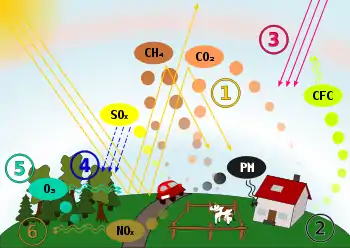
- NO2 + OH· → HNO3
Chemistry in cloud droplets
When clouds are present, the loss rate of SO2 is faster than can be explained by gas phase chemistry alone. This is due to reactions in the liquid water droplets.
- Hydrolysis
Sulfur dioxide dissolves in water and then, like carbon dioxide, hydrolyses in a series of equilibrium reactions:
- SO2 (g) + H2O ⇌ SO2·H2O
- SO2·H2O ⇌ H+ + HSO3−
- HSO3− ⇌ H+ + SO32−
- Oxidation
There are a large number of aqueous reactions that oxidize sulfur from S(IV) to S(VI), leading to the formation of sulfuric acid. The most important oxidation reactions are with ozone, hydrogen peroxide and oxygen (reactions with oxygen are catalyzed by iron and manganese in the cloud droplets).[8]
Acid deposition
Wet deposition
Wet deposition of acids occurs when any form of precipitation (rain, snow, and so on) removes acids from the atmosphere and delivers it to the Earth's surface. This can result from the deposition of acids produced in the raindrops (see aqueous phase chemistry above) or by the precipitation removing the acids either in clouds or below clouds. Wet removal of both gases and aerosols are both of importance for wet deposition.[52]
Adverse effects
Acid rain has been shown to have adverse impacts on forests, freshwaters and soils, killing insect and aquatic life-forms as well as causing damage to buildings and having impacts on human health.
Surface waters and aquatic animals
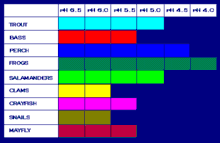
Both the lower pH and higher aluminium concentrations in surface water that occur as a result of acid rain can cause damage to fish and other aquatic animals. At pH lower than 5 most fish eggs will not hatch and lower pH can kill adult fish. As lakes and rivers become more acidic biodiversity is reduced. Acid rain has eliminated insect life and some fish species, including the brook trout in some lakes, streams, and creeks in geographically sensitive areas, such as the Adirondack Mountains of the United States.[54] However, the extent to which acid rain contributes directly or indirectly via runoff from the catchment to lake and river acidity (i.e., depending on characteristics of the surrounding watershed) is variable. The United States Environmental Protection Agency's (EPA) website states: "Of the lakes and streams surveyed, acid rain caused acidity in 75% of the acidic lakes and about 50% of the acidic streams".[54] Lakes hosted by silicate basement rocks are more acidic than lakes within limestone or other basement rocks with a carbonate composition (i.e. marble) due to buffering effects by carbonate minerals, even with the same amount of acid rain.[55]
Soils
Soil biology and chemistry can be seriously damaged by acid rain. Some microbes are unable to tolerate changes to low pH and are killed.[56] The enzymes of these microbes are denatured (changed in shape so they no longer function) by the acid. The hydronium ions of acid rain also mobilize toxins, such as aluminium, and leach away essential nutrients and minerals such as magnesium.[57]
- 2 H+ (aq) + Mg2+ (clay) ⇌ 2 H+ (clay) + Mg2+ (aq)
Soil chemistry can be dramatically changed when base cations, such as calcium and magnesium, are leached by acid rain, thereby affecting sensitive species, such as sugar maple (Acer saccharum).[58][59]
Soil acidification
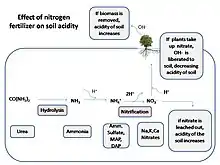
Impacts of acidic water and Soil acidification on plants could be minor or in most cases major. Most minor cases which do not result in fatality of plant life can be attributed to the plants being less susceptible to acidic conditions and/or the acid rain being less potent. However, even in minor cases, the plant will eventually die due to the acidic water lowering the plant's natural pH.[60] Acidic water enters the plant and causes important plant minerals to dissolve and get carried away; which ultimately causes the plant to die of lack of minerals for nutrition. In major cases, which are more extreme, the same process of damage occurs as in minor cases, which is removal of essential minerals, but at a much quicker rate.[61] Likewise, acid rain that falls on soil and on plant leaves causes drying of the waxy leaf cuticle, which ultimately causes rapid water loss from the plant to the outside atmosphere and eventually results in death of the plant.[62] To see if a plant is being affected by soil acidification, one can closely observe the plant leaves. If the leaves are green and look healthy, the soil pH is normal and acceptable for plant life. But if the plant leaves have yellowing between the veins on their leaves, that means the plant is suffering from acidification and is unhealthy.[63] Moreover, a plant suffering from soil acidification cannot photosynthesize; the acid-water-induced process of drying out of the plant can destroy chloroplast organelles.[64] Without being able to photosynthesize, a plant cannot create nutrients for its own survival or oxygen for the survival of aerobic organisms, which affects most species on Earth and ultimately ends the purpose of the plant's existence.[65]
Forests and other vegetation
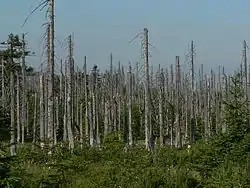
Adverse effects may be indirectly related to acid rain, like the acid's effects on soil (see above) or high concentration of gaseous precursors to acid rain. High altitude forests are especially vulnerable as they are often surrounded by clouds and fog which are more acidic than rain.[66]
Other plants can also be damaged by acid rain, but the effect on food crops is minimized by the application of lime and fertilizers to replace lost nutrients. In cultivated areas, limestone may also be added to increase the ability of the soil to keep the pH stable, but this tactic is largely unusable in the case of wilderness lands. When calcium is leached from the needles of red spruce, these trees become less cold tolerant and exhibit winter injury and even death.[67][68]
Ocean acidification
Acid rain has a much less harmful effect on oceans on a global scale, but it creates an amplified impact in the shallower waters of coastal waters.[69] Acid rain can cause the ocean's pH to fall, known as ocean acidification, making it more difficult for different coastal species to create their exoskeletons that they need to survive. These coastal species link together as part of the ocean's food chain, and without them being a source for other marine life to feed off of, more marine life will die.[70] Coral's limestone skeleton is particularly sensitive to pH decreases, because the calcium carbonate, a core component of the limestone skeleton, dissolves in acidic (low pH) solutions.
In addition to acidification, excess nitrogen inputs from the atmosphere promote increased growth of phytoplankton and other marine plants, which, in turn, may cause more frequent harmful algal blooms and eutrophication (the creation of oxygen-depleted “dead zones”) in some parts of the ocean.[71]
Human health effects
Acid rain does not directly affect human health. The acid in the rainwater is too dilute to have direct adverse effects. The particulates responsible for acid rain (sulfur dioxide and nitrogen oxides) do have an adverse effect. Increased amounts of fine particulate matter in the air contribute to heart and lung problems, including asthma and bronchitis.[72]
Other adverse effects


Acid rain can damage buildings, historic monuments, and statues, especially those made of rocks, such as limestone and marble, that contain large amounts of calcium carbonate. Acids in the rain react with the calcium compounds in the stones to create gypsum, which then flakes off.
- CaCO3 (s) + H2SO4 (aq) ⇌ CaSO4 (s) + CO2 (g) + H2O (l)
The effects of this are commonly seen on old gravestones, where acid rain can cause the inscriptions to become completely illegible. Acid rain also increases the corrosion rate of metals, in particular iron, steel, copper and bronze.[73][74]
Affected areas
Places significantly impacted by acid rain around the globe include most of eastern Europe from Poland northward into Scandinavia,[75] the eastern third of the United States,[76] and southeastern Canada. Other affected areas include the southeastern coast of China and Taiwan.[77]
Prevention methods
Technical solutions
Many coal-firing power stations use flue-gas desulfurization (FGD) to remove sulfur-containing gases from their stack gases. For a typical coal-fired power station, FGD will remove 95% or more of the SO2 in the flue gases. An example of FGD is the wet scrubber which is commonly used. A wet scrubber is basically a reaction tower equipped with a fan that extracts hot smoke stack gases from a power plant into the tower. Lime or limestone in slurry form is also injected into the tower to mix with the stack gases and combine with the sulfur dioxide present. The calcium carbonate of the limestone produces pH-neutral calcium sulfate that is physically removed from the scrubber. That is, the scrubber turns sulfur pollution into industrial sulfates.
In some areas the sulfates are sold to chemical companies as gypsum when the purity of calcium sulfate is high. In others, they are placed in landfill. The effects of acid rain can last for generations, as the effects of pH level change can stimulate the continued leaching of undesirable chemicals into otherwise pristine water sources, killing off vulnerable insect and fish species and blocking efforts to restore native life.
Fluidized bed combustion also reduces the amount of sulfur emitted by power production.
Vehicle emissions control reduces emissions of nitrogen oxides from motor vehicles.
International treaties
International treaties on the long-range transport of atmospheric pollutants have been agreed for example, the 1985 Helsinki Protocol on the Reduction of Sulphur Emissions under the Convention on Long-Range Transboundary Air Pollution. Canada and the US signed the Air Quality Agreement in 1991. Most European countries and Canada have signed the treaties.
Emissions trading
In this regulatory scheme, every current polluting facility is given or may purchase on an open market an emissions allowance for each unit of a designated pollutant it emits. Operators can then install pollution control equipment, and sell portions of their emissions allowances they no longer need for their own operations, thereby recovering some of the capital cost of their investment in such equipment. The intention is to give operators economic incentives to install pollution controls.
The first emissions trading market was established in the United States by enactment of the Clean Air Act Amendments of 1990.[78] The overall goal of the Acid Rain Program established by the Act[79] is to achieve significant environmental and public health benefits through reductions in emissions of sulfur dioxide (SO2) and nitrogen oxides (NOx), the primary causes of acid rain. To achieve this goal at the lowest cost to society, the program employs both regulatory and market based approaches for controlling air pollution.
See also
References
- Kjellstrom, Tord; Lodh, Madhumita; McMichael, Tony; Ranmuthugala, Geetha; Shrestha, Rupendra; Kingsland, Sally (2006), Jamison, Dean T.; Breman, Joel G.; Measham, Anthony R.; Alleyne, George (eds.), "Air and Water Pollution: Burden and Strategies for Control", Disease Control Priorities in Developing Countries (2nd ed.), World Bank, ISBN 978-0-8213-6179-5, PMID 21250344, retrieved April 22, 2020
- Sisterson, D. L.; Liaw, Y. P. (January 1, 1990). "An evaluation of lightning and corona discharge on thunderstorm air and precipitation chemistry". Journal of Atmospheric Chemistry. 10 (1): 83–96. Bibcode:1990JAtC...10...83S. doi:10.1007/BF01980039. ISSN 1573-0662. S2CID 97714446.
- Magaino, S. (January 1, 1997). "Corrosion rate of copper rotating-disk-electrode in simulated acid rain". Electrochimica Acta. 42 (3): 377–382. doi:10.1016/S0013-4686(96)00225-3. ISSN 0013-4686.
- Likens, Gene E.; Keene, William C.; Miller, John M.; Galloway, James N. (1987). "Chemistry of precipitation from a remote, terrestrial site in Australia". Journal of Geophysical Research. 92 (D11): 13299. Bibcode:1987JGR....9213299L. doi:10.1029/JD092iD11p13299.
- E. S. de Beer, ed. The Diary of John Evelyn, III, 1955 (September 19, 1667) p. 495.
- Glossary, United States: NASA Earth Observatory, acid rain, archived from the original on December 13, 2011, retrieved February 15, 2013
- Weathers, K. C. and Likens, G. E. (2006). "Acid rain", pp. 1549–1561 in: W. N. Rom and S. Markowitz (eds.). Environmental and Occupational Medicine. Lippincott-Raven Publ., Philadelphia. Fourth Edition, ISBN 0-7817-6299-5.
- Seinfeld, John H.; Pandis, Spyros N (1998). Atmospheric Chemistry and Physics — From Air Pollution to Climate Change. John Wiley and Sons, Inc. ISBN 978-0-471-17816-3
- Likens, G. E.; Bormann, F. H.; Johnson, N. M. (1972). "Acid rain". Environment. 14 (2): 33–40. doi:10.1080/00139157.1972.9933001.
- Acid Rain in New England, A Brief History Archived September 25, 2010, at the Wayback Machine. Epa.gov. Retrieved on February 9, 2013.
- Brøgger, Waldemar Christofer (1881). "Note on a contaminated snowfall under the heading Mindre meddelelser (Short communications)". Naturen. 5: 47.
- Likens, G. E.; Bormann, F. H. (1974). "Acid Rain: A Serious Regional Environmental Problem". Science. 184 (4142): 1176–9. Bibcode:1974Sci...184.1176L. doi:10.1126/science.184.4142.1176. PMID 17756304. S2CID 24124373.
- Keller, C. K.; White, T. M.; O'Brien, R.; Smith, J. L. (2006). "Soil CO2 dynamics and fluxes as affected by tree harvest in an experimental sand ecosystem". Journal of Geophysical Research. 111 (G3): G03011. Bibcode:2006JGRG..111.3011K. doi:10.1029/2005JG000157.
- Galloway, JN; Dianwu, Z; Jiling, X; Likens, GE (1987). "Acid rain: China, United States, and a remote area". Science. 236 (4808): 1559–62. Bibcode:1987Sci...236.1559G. doi:10.1126/science.236.4808.1559. PMID 17835740. S2CID 39308177.
- Chandru (September 9, 2006). "CHINA: Industrialization pollutes its country side with Acid Rain". Southasiaanalysis.org. Archived from the original on June 20, 2010. Retrieved November 18, 2010.
- Lefohn, A.S.; Husar, J.D.; Husar, R.B. (1999), Global Sulfur Emissions Database, United States: A.S.L. & Associates
- Likens, G. E.; Wright, R. F.; Galloway, J. N.; Butler, T. J. (1979). "Acid rain". Scientific American. 241 (4): 43–51. Bibcode:1979SciAm.241d..43L. doi:10.1038/scientificamerican1079-43.
- Likens, G. E. (1984). "Acid rain: the smokestack is the "smoking gun"". Garden. 8 (4): 12–18.
- "Art Under Wraps", Harvard Magazine, March–April 2000
- Likens, Gene E.; Bormann, F. Herbert; Johnson, Noye M. (1972). "Acid Rain". Environment: Science and Policy for Sustainable Development. 14 (2): 33–40. doi:10.1080/00139157.1972.9933001.
- Johnson, Noye M.; Driscoll, Charles T.; Eaton, John S.; Likens, Gene E.; McDowell, William H. (September 1, 1981). "'Acid rain', dissolved aluminum and chemical weathering at the Hubbard Brook Experimental Forest, New Hampshire". Geochimica et Cosmochimica Acta. 45 (9): 1421–1437. Bibcode:1981GeCoA..45.1421J. doi:10.1016/0016-7037(81)90276-3.
- Hall, Ronald J.; Likens, Gene E.; Fiance, Sandy B.; Hendrey, George R. (August 1, 1980). "Experimental Acidification of a Stream in the Hubbard Brook Experimental Forest, New Hampshire". Ecology. 61 (4): 976–989. doi:10.2307/1936765. ISSN 1939-9170. JSTOR 1936765.
- Lackey, R.T. (1997). "Science, policy, and acid rain: lessons learned" (PDF). Renewable Resources Journal. 15 (1): 9–13.
- Winstanley, Derek; Lackey, Robert T.; Warnick, Walter L.; Malanchuk, John (1998). "Acid rain: Science and policy making". Environmental Science & Policy. 1: 51. doi:10.1016/S1462-9011(98)00006-9.
- Times, Robert Reinhold, Special To The New York (June 8, 1982). "ACID RAIN ISSUE CREATES STRESS BETWEEN ADMINISTRATION AND SCIENCE ACADEMY". The New York Times. ISSN 0362-4331. Retrieved November 16, 2016.
- "Ronald Reagan on Environment". www.ontheissues.org. Retrieved November 16, 2016.
- "HYSTERIA ABOUT ACID RAIN Even Ronald Reagan now casts it as the villain. He is overriding a lot of scientific evidence. - April 14, 1986". archive.fortune.com. Retrieved November 16, 2016.
- "Ronald Reagan: Nomination of William A. Nierenberg To Be a Member of the National Science Board". www.presidency.ucsb.edu. Retrieved November 16, 2016.
- "Report of the Acid Rain Peer Review Panel". Document Display | NEPIS | US EPA. July 1984. Retrieved November 16, 2016.
- "From tobacco to climate change, 'merchants of doubt' undermined the science". Grist. April 17, 2010. Retrieved November 16, 2016.
- Franklin, Ben A. (August 18, 1984). "LEGISLATORS SAT WHITE HOUSE SUPPRESSED ACID RAIN REPORT". The New York Times. ISSN 0362-4331. Retrieved November 16, 2016.
- The US National Acid Precipitation Assessment Program : 1990 integrated assessment report. Washington, D.C. : National Acid Precipitation Assessment Program, Office of the Director, [1991]
- "Clean Air Act Title IV - Subchapter A: Acid Deposition Control | Overview of the Clean Air Act and Air Pollution | US EPA". Epa.gov. June 3, 2015. Retrieved March 20, 2018.
- John Bachmann, David Calkins, Margo Oge. “Cleaning the Air We Breathe: A Half Century of Progress.” EPA Alumni Association. September 2017. Pages 26-27.
- "US EPA: A Brief History of Acid Rain". United States Environmental Protection Agency. 2002. Archived from the original on September 25, 2010. Retrieved November 18, 2010.
- 'Cap-and-trade' model eyed for cutting greenhouse gases, San Francisco Chronicle, December 3, 2007.
- "Facts On File News Services Databases". 2facts.com. Retrieved November 18, 2010.
- Gilberston, T. and Reyes, O. 2009. Carbon Trading: how it works and why it fails. Dag Hammarskjöld Foundation: 22
- Acid Rain Program 2007 Progress Report, United States Environmental Protection Agency, January 2009.
- Gerdes, Justin. "Cap and Trade Curbed Acid Rain: 7 Reasons Why It Can Do The Same For Climate Change". Forbes. Forbes. Retrieved October 27, 2014.
- Muki Haklay (2015). "Citizen Science and Policy: A European Perspective" (PDF). Woodrow Wilson International Center for Scholars. p. 11. Retrieved June 3, 2016.
- R. Kerson (1989). "Lab for the Environment". MIT Technology Review. Vol. 92 no. 1. pp. 11–12.
- "IISD Experimental Lakes Area: The world's living freshwater laboratory". BioLab Business Magazine. February 12, 2020. Retrieved July 6, 2020.
- Luoma, Jon R. (September 13, 1988). "Bold Experiment in Lakes Tracks the Relentless Toll of Acid Rain". The New York Times. ISSN 0362-4331. Retrieved July 6, 2020.
- "A Canadian Scientist Explains How Acid Rain is Still Making its Mark". IISD Experimental Lakes Area. May 16, 2018. Retrieved July 6, 2020.
- Canada, Environment and Climate Change (June 3, 2004). "Acid rain history". aem. Retrieved July 6, 2020.
- Berresheim, H.; Wine, P.H. and Davies D.D. (1995). "Sulfur in the Atmosphere". In Composition, Chemistry and Climate of the Atmosphere, ed. H.B. Singh. Van Nostrand Rheingold ISBN 0-442-01264-0
- Nemecek, T.; Poore, J. (June 1, 2018). "Reducing food's environmental impacts through producers and consumers". Science. 360 (6392): 987–992. Bibcode:2018Sci...360..987P. doi:10.1126/science.aaq0216. ISSN 0036-8075. PMID 29853680.
- Floor, G. H.; Calabrese, S.; Román-Ross, G.; D´Alessandro, W.; Aiuppa, A. (October 23, 2011). "Selenium mobilization in soils due to volcanic derived acid rain: An example from Mt Etna volcano, Sicily". Chemical Geology. 289 (3): 235–244. Bibcode:2011ChGeo.289..235F. doi:10.1016/j.chemgeo.2011.08.004. hdl:10447/66526. ISSN 0009-2541.
- "Acid Rain: Causes, Effects and Solutions". July 14, 2018. Retrieved August 23, 2019.
- Clean Air Act Reduces Acid Rain In Eastern United States, ScienceDaily, September 28, 1998
- US EPA, OAR (February 9, 2016). "What is Acid Rain?". US EPA. Retrieved April 14, 2020.
- "UK National Air Quality Archive: Air Pollution Glossary". Airquality.co.uk. April 1, 2002. Archived from the original on April 17, 2009. Retrieved November 18, 2010.
- US EPA: Effects of Acid Rain – Surface Waters and Aquatic Animals
- Kesler, Stephen (2015). Mineral Resources, Economics and the Environment. Cambridge University. ISBN 9781107074910.
- Rodhe, H., et al. The global distribution of acidifying wet deposition. Environmental Science and TEchnology. vlo. 36, no. 20 (October) p. 4382–8
- US EPA: Effects of Acid Rain – Forests Archived July 26, 2008, at the Wayback Machine
- Likens, G.E.; Driscoll, C.T.; Buso, D.C.; Mitchell, M.J.; Lovett, G.M.; Bailey, S.W.; Siccama, T.G.; Reiners, W.A.; Alewell, C. (2002). "The biogeochemistry of sulfur at Hubbard Brook" (PDF). Biogeochemistry. 60 (3): 235. doi:10.1023/A:1020972100496. S2CID 98347112.
- Likens, G. E.; Driscoll, C. T.; Buso, D. C. (1996). "Long-Term Effects of Acid Rain: Response and Recovery of a Forest Ecosystem" (PDF). Science. 272 (5259): 244. Bibcode:1996Sci...272..244L. doi:10.1126/science.272.5259.244. S2CID 178546205.
- Larssen, T.; Carmichael, G. R. (October 1, 2000). "Acid rain and acidification in China: the importance of base cation deposition". Environmental Pollution. 110 (1): 89–102. doi:10.1016/S0269-7491(99)00279-1. ISSN 0269-7491. PMID 15092859.
- Markewitz, Daniel; Richter, Daniel D.; Allen, H. Lee; Urrego, J. Byron (1998). "Three Decades of Observed Soil Acidification in the Calhoun Experimental Forest: Has Acid Rain Made a Difference?". Soil Science Society of America Journal. 62 (5): 1428–1439. Bibcode:1998SSASJ..62.1428M. doi:10.2136/sssaj1998.03615995006200050040x. ISSN 1435-0661.
- Evans, Lance S.; Gmur, Nicholas F.; Costa, Filomena Da (1977). "Leaf Surface and Histological Perturbations of Leaves of Phaseolus Vulgaris and Helianthus Annuus After Exposure to Simulated Acid Rain". American Journal of Botany. 64 (7): 903–913. doi:10.1002/j.1537-2197.1977.tb11934.x. ISSN 1537-2197.
- Du, Yan-Jun; Wei, Ming-Li; Reddy, Krishna R.; Liu, Zhao-Peng; Jin, Fei (April 30, 2014). "Effect of acid rain pH on leaching behavior of cement stabilized lead-contaminated soil". Journal of Hazardous Materials. 271: 131–140. doi:10.1016/j.jhazmat.2014.02.002. ISSN 0304-3894. PMID 24637445.
- Sun, Jingwen; Hu, Huiqing; Li, Yueli; Wang, Lihong; Zhou, Qing; Huang, Xiaohua (September 1, 2016). "Effects and mechanism of acid rain on plant chloroplast ATP synthase". Environmental Science and Pollution Research. 23 (18): 18296–18306. doi:10.1007/s11356-016-7016-3. ISSN 1614-7499. PMID 27278067. S2CID 22862843.
- Stoyanova, D.; Velikova, V. (December 1, 1997). "Effects of Simulated Acid Rain on Chloroplast Ultrastructure of Primary Leaves of Phaseolus Vulgaris". Biologia Plantarum. 40 (4): 589–595. doi:10.1023/A:1001761421851. ISSN 1573-8264. S2CID 20728684.
- Johnson, Dale W.; Turner, John; Kelly, J. M. (1982). "The effects of acid rain on forest nutrient status". Water Resources Research. 18 (3): 449–461. Bibcode:1982WRR....18..449J. doi:10.1029/WR018i003p00449. ISSN 1944-7973.
- DeHayes, D.H., Schaberg, P.G. and G.R. Strimbeck. (2001). Red Spruce Hardiness and Freezing Injury Susceptibility. In: F. Bigras, ed. Conifer Cold Hardiness. Kluwer Academic Publishers, the Netherlands ISBN 0-7923-6636-0.
- Lazarus, Brynne E.; Schaberg, Paul G.; Hawley, Gary J.; DeHayes, Donald H. (2006). "Landscape-scale spatial patterns of winter injury to red spruce foliage in a year of heavy region-wide injury" (PDF). Can. J. For. Res. 36: 142–152. doi:10.1139/x05-236. highbeam copy
- "Acid Rain Has A Disproportionate Impact On Coastal Waters". ScienceDaily. Retrieved June 26, 2020.
- "Acid Rain Has Disproportionate Impact on Near-Shore Ocean Waters - Windows to the Universe". www.windows2universe.org.
- "Acid Rain Has A Disproportionate Impact On Coastal Waters". ScienceDaily. Retrieved June 26, 2020.
- Effects of Acid Rain – Human Health. Epa.gov (June 2, 2006). Retrieved on 2013-02-09.
- Reisener, A.; Stäckle, B.; Snethlage, R. (1995). "ICP on effects on materials". Water, Air, & Soil Pollution. 85 (4): 2701–2706. Bibcode:1995WASP...85.2701R. doi:10.1007/BF01186242. S2CID 94721996.
- "Approaches in modeling the impact of air pollution-induced material degradation" (PDF). Archived from the original (PDF) on July 16, 2011. Retrieved November 18, 2010.
- Ed. Hatier (1993). "Acid Rain in Europe". United Nations Environment Programme GRID Arendal. Archived from the original on August 22, 2009. Retrieved January 31, 2010.
- US Environmental Protection Agency (2008). "Clean Air Markets 2008 Highlights". Retrieved January 31, 2010.
- "Acid Rain - Green Education Foundation | GEF | Sustainability Education". www.greeneducationfoundation.org. Retrieved November 2, 2017.
- Former Deputy Administrator Hank Habicht talks about management at EPA. An Interview with Hank Habicht Video, Transcript (see p6). December 21, 2012.
- Clean Air Act Amendments of 1990, 42 U.S. Code 7651
External links
| Wikimedia Commons has media related to Acid rain. |
- National Acid Precipitation Assessment Program Report – a 98-page report to Congress (2005)
- Acid rain for schools
- Acid rain for schools – Hubbard Brook
- Acid Rain Retirement Fund environmental education links about acid rain
- United States Environmental Protection Agency – New England Acid Rain Program (superficial)
- Acid Rain (more depth than ref. above)
- U.S. Geological Survey – What is acid rain?
- Acid rain analysis – freeware for simulation and evaluation of titration curves and pH calculations
- CBC Digital Archives – Acid Rain: Pollution and Politics
- Larssen, Thorjørn et al. "Acid Rain in China". Environmental Science and Technology, 40:2, 2006, pp 418–425.
- Acid Rain: A Continuing National Tragedy – a report from The Adirondack Council on acid rain in the Adirondack region (1998)
- Assortment of Summaries on Acid Rain
- Acid rain linked to decline of the wood thrush, a songbird of the Eastern Forest
- Trouble in the Forest, a 1988 documentary hosted by David Suzuki
- What Happens to Acid Rain?
- Acid Rain and how it affects fish and other aquatic organisms